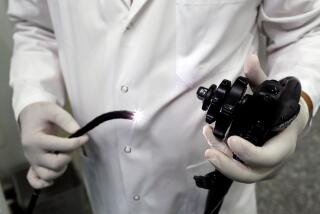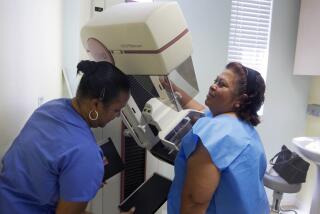Detecting breast cancer: Sonograms, 3-D mammography get closer look
- Share via
New research suggests that for women with dense breasts, conventional mammography supplemented by an ultrasound scan is a costly addition unlikely to improve detection or reduce breast-cancer deaths significantly. But compared with conventional mammography alone, 3-D mammography -- also called tomosynthesis -- does increase the likelihood of detecting cancer in women with dense breasts.
The new findings emerge from two separate studies. Collectively, they suggest that for women with dense breasts -- which both raises a woman’s risk of breast cancer and makes such malignancies harder to find on an imaging scan -- tomosynthesis might be a better cancer screening technique than standard mammography-plus-ultrasonography.
But neither study compared the two screening techniques head-to-head, and debate over how best to catch breast cancers in such women is certain to continue. More than 4 in 10 women between the ages of 40 and 74 are thought to have dense breasts.
In an article released Monday in the journal Annals of Internal Medicine, a team of preventive-care specialists from across the United States and the Netherlands joined forces to calculate the cost of and additional years of life gained by adding sonography to the mix of breast-cancer screening mechanisms. The study was commissioned by the National Cancer Institute.
The team found that adding sonography for all dense-breasted women between 50 and 74 who come up clean on a standard mammogram drove costs up considerably, but yielded only marginal health benefits. Some 3,000 such women would have to get the additional sonogram for one breast-cancer death to be averted.
(By comparison, the benefits of basic mammography screening for all women 50 to 74 are considerable: Models show that compared with a world in which no older women are screened for breast cancer, when all women in this age group get mammograms once every two years, 18 breast-cancer deaths for every 3,000 women are averted.)
In the process, sonogram scans would frequently turn up false positives, prompting many women to undertake the risk, cost and inconvenience of having a breast biopsy when they either do not have breast cancer or have forms of cancer that will not ultimately threaten their lives.
The new calculation comes as state and national legislatures debate whether to require that women with dense breasts be warned of their elevated cancer risk and offered the additional sonography screening.
Many breast cancer experts had hoped that hand-held sonograms would offer a safe, easy and inexpensive way to improve screening for breast cancer for women with dense breasts. But this rigorous comparison found that it was neither inexpensive, effective or even particularly safe, owing to the false-positives it turned up.
“Most people would be surprised by our result: that so few lives are saved and it’s at very high cost,” said Dr. Jeanne Mandelblatt, an oncologist and cancer epidemiologist at Georgetown University’s Lombardi Comprehensive Cancer Center.
“It remains possible that a better-performing technology with targeted application to women with dense breasts or women at higher than average risk would be useful,” the authors of the Annals study wrote.
A second study, presented last week at the annual meeting of the Radiological Society of North America, explored the potential benefits of digital breast tomosynthesis -- more commonly known as 3-D mammography -- in that role, and found the numbers promising. That study was funded by Hologic, Inc., a healthcare and diagnostics company that has aggressively promoted its 3-D imaging techniques.
In a head-to-head comparison of mammography alone with 3-D mammography for women with dense breasts, the study found that digital tomosynthesis significantly increased the cancer detection rate. Researchers performed both types of scans on more than 25,000 women, ages 50 to 69, and categorized the women by the density of their breasts.
Among women with dense breasts, researchers detected 80% of 132 breast cancers when they read the scan results generated by digital mammography-plus-tomosynthesis. When reading mammographic scans alone, researchers detected only 59% of those breast cancers.
The higher-tech scan, which recomputes the digital information captured by a mammogram to create a three-dimensional image of the breast, was also superior at detecting cancer in women with breasts that were less dense but more fatty -- a direction in which many women move as they grow older. Of the 257 cancers found in the entire population of 25,547 women, 82% were detected by the 3-D technique, compared with 63% detected by mammography alone.
“Tomosynthesis could be regarded as an improvement of mammography and would be much easier than MRI or ultrasound to implement in organized screening programs,” said the study’s senior investigator, Dr. Per Skaane of Oslo University Hospital’s Department of Radiology in Norway. “So the intention of our study was to see if tomosynthesis really would significantly increase the cancer detection rate in a population-based mammography screening program.”
Georgetown’s Mandelblatt called the trial comparing mammography and 3-D tomography “a step in the right direction” in helping women with dense breasts address their increased risk.
But she added that the true benefits of imaging techniques in detecting cancers must take into account how well they find the specific cancers that matter most -- those that will rise up to threaten a patient’s life. For that, she said, “you just need longer follow-up” of subjects in great numbers.
Follow me on Twitter @LATMelissaHealy and “like” Los Angeles Times Science & Health on Facebook.







